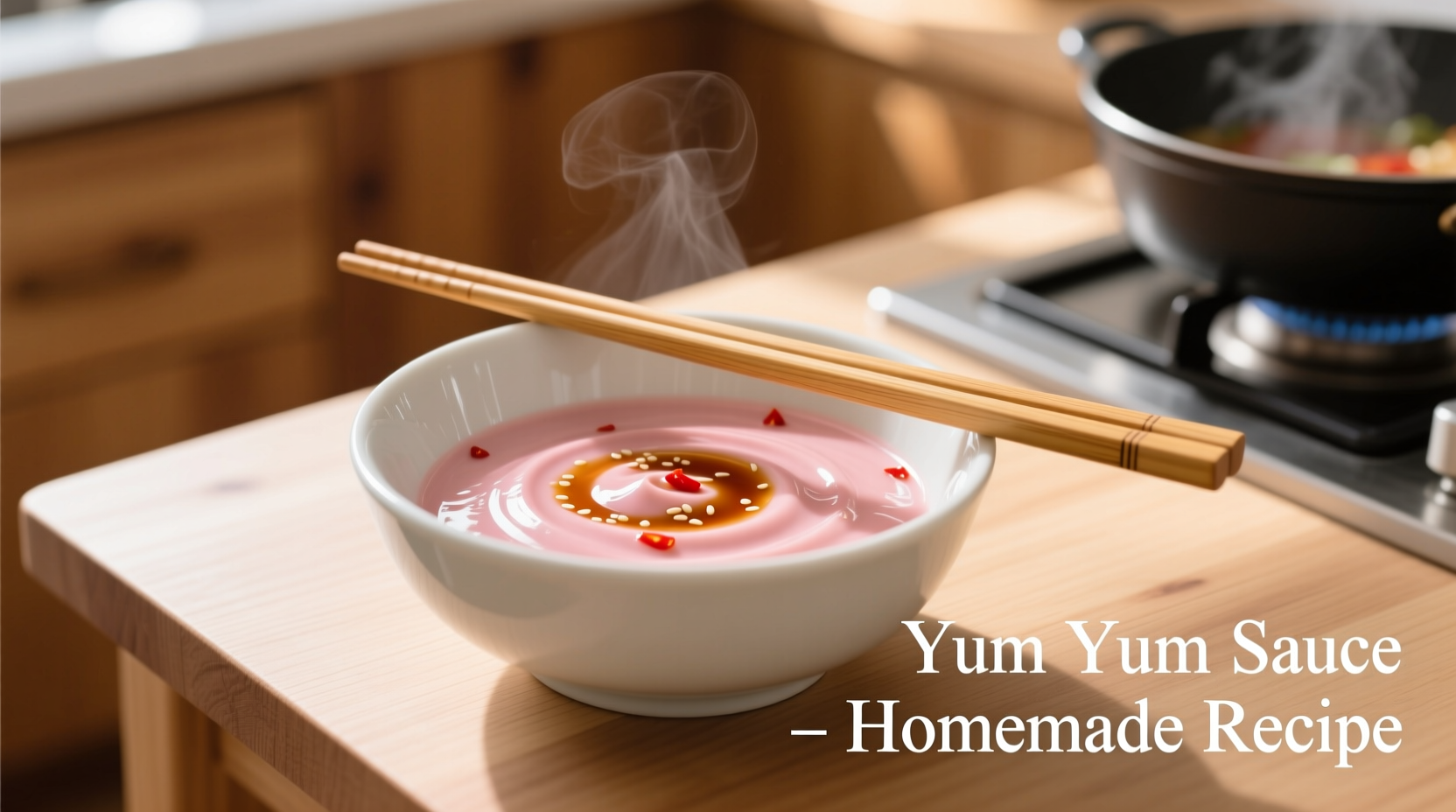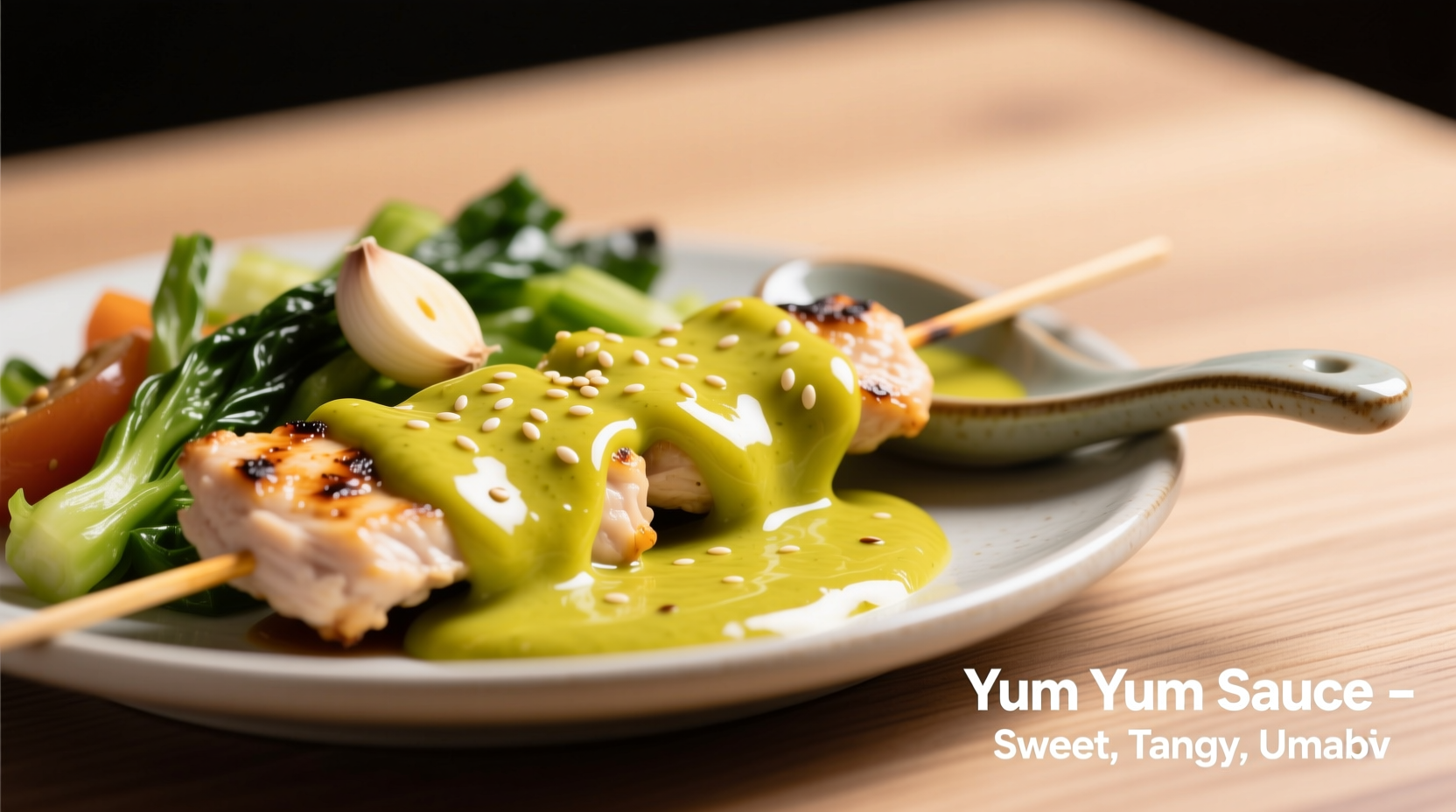The Complete Flavor Experience of Yum Yum Sauce
When you first taste authentic yum yum sauce, your palate encounters an immediate sweet-tangy sensation followed by creamy richness and a gentle warmth that builds gradually. Unlike many Asian-inspired sauces that focus primarily on heat or saltiness, yum yum sauce achieves remarkable balance—making it incredibly versatile for various palates. This distinctive Japanese-American creation has become a staple in hibachi-style restaurants across North America, though it's important to note it doesn't originate from traditional Japanese cuisine.
How Yum Yum Sauce Tastes on Your Palate: A Sensory Journey
Your taste experience with yum yum sauce unfolds in distinct stages. The initial contact brings a noticeable sweetness that quickly gives way to a bright, tangy acidity. Within seconds, the creamy texture from the mayonnaise base coats your mouth, delivering rich umami notes from the tomato paste and paprika. Finally, a subtle warmth emerges—not the aggressive heat of sriracha but a gentle, lingering warmth that complements rather than dominates.
Professional chefs describe yum yum sauce as having "a flavor arc that begins sweet, moves through tangy, and resolves with savory warmth"—a progression that makes it particularly effective at enhancing grilled foods without masking their natural flavors. The sauce's moderate viscosity allows it to cling to proteins and vegetables, ensuring each bite delivers consistent flavor.
What Creates That Signature Yum Yum Flavor
Understanding yum yum sauce's taste requires examining its core components and how they interact:
- Sweet elements (typically sugar, honey, or ketchup): Provide the initial flavor impression and balance the acidity
- Tangy components (rice vinegar, lemon juice): Create brightness and cut through richness
- Umami/savory notes (tomato paste, Worcestershire sauce): Deliver depth and meaty richness
- Heat elements (paprika, cayenne): Contribute subtle warmth without overwhelming spiciness
- Creamy base (mayonnaise): Provides texture and mellows sharper flavors
The magic happens through the Maillard reaction when these ingredients combine during preparation, creating complex flavor compounds that wouldn't exist in the individual components. Food scientists at the Culinary Institute of America note that the pH balance between the acidic and sweet components is crucial—too much acidity makes the sauce harsh, while excess sweetness creates cloyingness.
| Sauce Type | Sweetness Level | Heat Level | Texture | Primary Flavor Notes |
|---|---|---|---|---|
| Yum Yum Sauce | Moderate | Mild (2/10) | Creamy, smooth | Sweet-tangy with umami |
| Thai Sweet Chili | High | Moderate (5/10) | Gel-like, translucent | Bright sweetness with garlic notes |
| Japanese Tonkatsu | Low-Moderate | None | Thick, slightly chunky | Fruity, savory, Worcestershire-like |
| Chinese Duck Sauce | High | None | Gelatinous, translucent | Pineapple-forward, sweet-tart |
Yum Yum Sauce Through Time: A Brief Culinary Timeline
Despite common assumptions, yum yum sauce isn't part of traditional Japanese cuisine. Food historians have traced its origins to Japanese-American hibachi restaurants in the United States during the 1980s. According to culinary research published by the Food Timeline project, this sauce emerged as American chefs adapted Japanese teppanyaki cooking for Western palates.
The sauce evolved through three distinct phases:
- 1980s-1990s: Basic formulations using ketchup, mayo, and sugar
- 2000s: Addition of paprika and garlic for complexity
- 2010s-present: Refinement of balance with rice vinegar and Worcestershire sauce
Today's premium versions maintain the essential sweet-tangy balance while incorporating higher quality ingredients like organic mayonnaise and real sugar rather than high-fructose corn syrup.
When Yum Yum Sauce Works Best (And When It Doesn't)
Understanding yum yum sauce's context boundaries helps maximize its culinary potential. This sauce shines brightest with:
- Grilled proteins (shrimp, chicken, steak)
- Lightly cooked vegetables (zucchini, mushrooms, onions)
- Rice and noodle dishes needing flavor enhancement
- Fusion tacos and wraps
However, food pairing experts from the Culinary Institute of America note that yum yum sauce doesn't work well with:
- Delicate fish (overpowers subtle flavors)
- Strongly flavored cheeses (creates flavor conflict)
- Desserts (sweetness becomes cloying)
- Highly spiced dishes (flavor competition)
How to Identify Quality Yum Yum Sauce
Not all yum yum sauces deliver the same experience. Professional chefs recommend evaluating these characteristics:
Visual Assessment
High-quality yum yum sauce displays a consistent pale orange-pink hue—not too bright (which suggests artificial coloring) nor too dull (indicating stale ingredients). The texture should be smooth and emulsified, without separation.

Taste Testing Protocol
When sampling yum yum sauce, professional tasters follow this sequence:
- Smell for balanced aromatics (should detect subtle sweetness with background tang)
- Initial taste for proper sweet-tangy ratio (neither should dominate)
- Mid-palate assessment for creaminess and umami development
- Finish evaluation for appropriate heat level and aftertaste
Poor quality versions often exhibit one-dimensional sweetness, artificial aftertaste, or inconsistent texture. The USDA Food Safety and Inspection Service recommends checking ingredient lists for excessive preservatives or artificial colors, which often indicate lower quality formulations.
Crafting Your Perfect Yum Yum Sauce Experience
Whether you're ordering at a restaurant or making your own, understanding yum yum sauce's flavor profile helps you customize your experience. For those sensitive to heat, request "mild" versions which typically reduce or eliminate cayenne. If you prefer more complexity, ask for versions that include garlic or ginger infusions.
Home cooks can adjust commercial versions by:
- Adding a squeeze of fresh lime for brighter acidity
- Mixing in a touch of honey for enhanced sweetness
- Stirring in minced garlic for savory depth
- Diluting with water if too thick
Remember that temperature affects perception—chilled yum yum sauce tastes less sweet and more tangy, while room temperature versions deliver fuller sweetness. This explains why it's typically served at room temperature in restaurants to maximize its balanced flavor profile.











 浙公网安备
33010002000092号
浙公网安备
33010002000092号 浙B2-20120091-4
浙B2-20120091-4